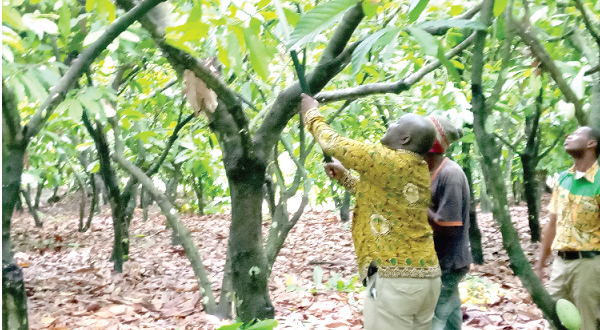Ghana is expected to produce more than one million tonnes of cocoa at the end of the 2018/19 cocoa season, the Brong Ahafo Regional Manager of the Cocoa Health and Extension Division (CHED) of the Ghana Cocoa Board (COCOBOD), Dr Emmanuel Nii Tackie-Otoo, has said.
According to him, the implementation of the cocoa flower pollination and pruning exercises, coupled with other measures, was yielding the desired results, thereby pointing to a bumper harvest of the country’s golden pod at the end of the 2018/19 season.
In the 2016/17 cocoa season, the country produced 900,000 metric tonnes of cocoa.
Dr Tackie-Otoo made this known when he led some farmhands who had been engaged in the pruning exercise to prune part of the 5.7 hectare cocoa farm belonging to the Omanhene of the Bechem Traditional Area, Nana Fosu Gyeabuor Akoto II, at Bechem Junction in the Brong Ahafo Region.
“With the intervention of the pollination exercise, some beneficiaries who were harvesting three bags per 0.41 hectare are now harvesting between 12 and 15 bags per 0.41 hectare,” he stated.
Pollination/pruning exercises
He said since Ghana accrued one million metric tonnes of cocoa during the 2010/11 cocoa season, the production of the crop had been fluctuating, notwithstanding the provision of fertiliser and the adoption of other measures.
He said it was a result of the situation that the pollination exercise was introduced on a pilot basis last year to increase the yield of the crop.
Dr Tackie-Otoo said after piloting the pollination programme, it was realised that there was the need to prune cocoa farms to boost flowering of the cocoa trees to ensure the success of the pollination exercise.
He said 15,120 hectares of cocoa farms between the production age of 10 and 20 years were expected to be pruned within the eight cocoa districts of the Brong Ahafo Region.
According to him, 2,834 labourers had been employed to prune and cut down some cocoa trees in order to provide sunshine and air needed for the flowering of cocoa trees.
“When we started the pollination exercise last year, the flowering situation in some farms was not the best. The pruning is, therefore, aimed at enhancing flowering initiation and retention. This will help the penetration of sunlight, which is needed for photosynthesis. The pruning exercise will also reduce the incidence of black pods on cocoa farms as a result of aeration,” he added.
He explained that in addition to the pruning exercise, “we are also removing mistletoe, a parasitic plant which depends on the cocoa plant for its survival, thereby reducing the amount of yield of the cocoa tree”.
Dr Tackie-Otoo said so far 11,308.64 hectares of cocoa farms had been pruned, while 17,916 farmers were benefiting from the exercise in the region.
Asked whether some of the farmers were not resisting the cutting down of some trees during the exercise, he said: “The farmers are rather happy when they see that their cocoa trees are bearing more flowers.”
He said in addition to the pollination and the pruning exercises, the farmers were being provided with liquid fertiliser (Sedaco and Benzai) meant to induce flower development free of charge.
Omanhene’s advice
For his part, Nana Akoto called on the government to adopt policies and programmes that would attract the youth to the agricultural sector of the economy, explaining that “we cannot continue to depend on agriculture as the backbone of the economy if the youth are not attracted to the sector”.
He also urged farmers to adopt the best agronomic practices being imparted to them by extension officers to obtain maximum production from their farms.
Source: Graphic.com.gh
 Public Agenda NewsPaper Ghana's only Advocacy & Development Newspaper
Public Agenda NewsPaper Ghana's only Advocacy & Development Newspaper






